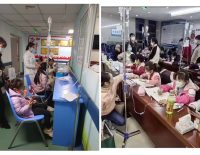Bihari researcher with other two summarize interactions at interface of SARS coronavirus ‘S’ protein and human ACE2 receptor protein

Severe Acute Respiratory Syndrome Coronavirus-2 (SARS-CoV-2) is a newly emerging, highly transmissible, and pathogenic coronavirus in humans that has caused global public health emergencies and economic crises.
Since the outbreak of COVID19 across the world, the human lifestyle has changed drastically. As we know that there is no vaccine available against this Corona visrus, only prevention is the treatment. Indian researchers have strategically forged a collaboration that has resulted in an excellent manuscript on the SARS coronavirus in the highly prestigious international journal PLoS Pathogens.
Dr. Sujeet Kumar is the lead author of the paper, hailing from Bihar, and has decade-long research career in USA and Canada. He has obtained advanced training at All India Institute of Medical Sciences (AIIMS), New Delhi. He is currently pursuing research on understanding the molecular mechanism of protein dysregulation with strong emphasis for knowledge advancements towards personalized therapeutic approaches. In this COVID19 paper, the researchers summarize the structural detail of the virus machinery RdRp (RNA-dependent RNA polymerase) used for viral genome replication/gene transcription. The high-impact paper also summarizesthe details of interactions at the interface of SARS coronavirus ‘S’ protein and the human ACE2 receptor protein that prompts up the ‘kiss of death’ leading to virus internalization and the havoc it creates thereafter.
Severe Acute Respiratory Syndrome Coronavirus-2 (SARS-CoV-2) is a newly emerging, highly transmissible, and pathogenic coronavirus in humans that has caused global public health emergencies and economic crises. Viral entry into the host cell is a multistep process in which SARS-CoV-2 utilizes the receptor-binding domain (RBD) of the spike (S) glycoprotein to recognize angiotensin-converting enzyme 2 (ACE2) receptors on the human cells; this initiates host-cell entry by promoting viral–host cell membrane fusion through large-scale conformational changes in the S protein. Receptor recognition and fusion are critical and essential steps of viral infections and are key determinants of the viral host range and cross-species transmission.
In this paper, the current knowledge on the origin and evolution of SARS-CoV-2 and the roles of key viral factors has been summarized, the structure of RNA-dependent RNA polymerase (RdRp) of SARS-CoV-2 and its significance in drug discovery and explain the receptor recognition mechanisms of coronavirus.
Before 2003, only 2 human coronaviruses—Human Coronavirus (HCoV)-229E and HCo- V-OC43, causing mild illness—were known. However, the emergence of Severe Acute Respiratory Syndrome Coronavirus (SARS-CoV) and Middle East Respiratory Syndrome Coronavirus (MERS-CoV) changed the view worldwide because coronaviruses can cause life-threatening infections. The ongoing pandemic of a novel strain of coronavirus, Severe Acute Respiratory Syndrome Coronavirus-2 (SARS-CoV-2), is posing unforeseen public health and economic threats worldwide. As of June 27, 2020, SARS-CoV-2 has infected more than 9.65 million people, with 491,115 deaths reported from 215 countries and territories, of which there are 2,407,590 confirmed cases of COVID-19 and 124,161 deaths in the United States of America alone. Recombination, mutator alleles, and mutational robustness are some of the evolutionary mechanisms [9] that make coronaviruses capable of expanding their host ranges, including humans. Therefore, understanding the virology of the coronaviruses at a structural level is of utmost importance because the health threats from these zoonotic viruses are constant and long-term.

Coronaviruses are large, enveloped, positive-stranded RNA viruses responsible for infecting a wide variety of mammalian and avian species. These viruses contain spike-like projections of glycoproteins on their surface, which appear like a crown under the electron microscope; hence, they are referred to as coronaviruses. The coronavirus genome encodes several structural and nonstructural proteins. The structural proteins are responsible for host infection, membrane fusion, viral assembly, morphogenesis, and release of virus particles, among other functions, and the nonstructural proteins (nsps) facilitate viral replication and transcription. The membrane (M), the envelope (E), and the spike protein (S) make up the structural proteins and are associated with the envelope. Among these structural proteins, the trimeric S proteins protrude from the virus envelope and are the key machinery that facilitates virus entry into the host cell.
The S proteins are clove-shaped, type-I transmembrane proteins and have 3 segments: a large ectodomain, a single-pass transmembrane, and an intracellular tail. The ectodomain of S proteins consist of the S1 subunit, containing a receptor-binding domain (RBD), and the membrane-fusion subunit (S2). The host-cell receptor recognition by the RBDs on S proteins is the initial step of viral infection, and the binding interactions between the coronavirus spike and its receptor is one of the most critical factors for host range and cross-species transmission.
Human coronaviruses recognize a variety of host receptors; specifically, HCoV-229E recognizes human aminopeptidase N (hAPN), MERS-CoV binds dipeptidyl peptidase-4 (DPP4), HCoV-OC43 and HCoV-HKU1 bind certain types of O-acetylated sialic acid, and HCoV-NL63 and SARS-CoV recognize angiotensin-converting enzyme 2 (ACE2). Recent structures, along with functional studies, have suggested that the SARS-CoV-2 S proteins utilize ACE2 and Transmembrane Serine Protease 2 (TMPRSS2) for host-cell entry,
which are very similar to the mechanisms exploited by SARS-CoV. See the “Structure, function, antigenicity, and hACE2 receptor recognition by the SARS-CoV-2 S glycoprotein” section of this review for detailed information on the mechanism of coronavirus cell entry mediated by the viral S glycoproteins. The S proteins, common among all coronaviruses, are a major target for eliciting antibodies; therefore, structural and molecular details of S protein and its interactions with cognate receptors would be vital in developing vaccines and antiviral drugs against SARS-CoV-2.
In this review, we discuss the coronavirus classification, details of SARS-CoV-2 emergence, morphology, and key virulence factors. We specifically explain the structure of RNA-dependent RNA polymerase of SARS-CoV-2 and its significance in drug discovery.

 (3 votes, average: 4.67 out of 5)
(3 votes, average: 4.67 out of 5)






Comments